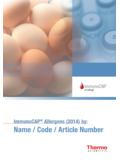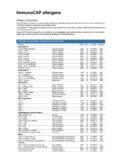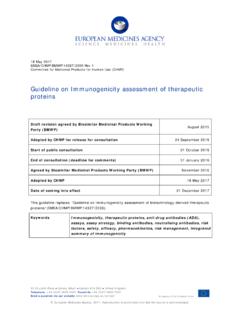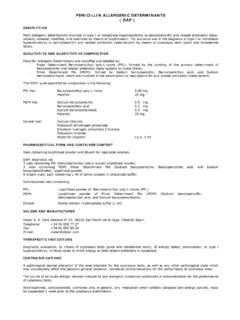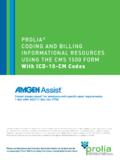Transcription of Improved risk assessment in hazelnut allergy - …
1 HazelnutMolecular Allergology use components for better management of hazelnut allergic patientsImproved risk assessment in hazelnut allergyTake the diagnosis and management of hazelnut allergic patients to a whole new levelDistinguish between allergy due to cross-reactivity and primary hazelnut allergy allergy to hazelnut (Corylus avellana) is often a consequence of cross-reactivity in tree pollen allergic patients or patients with fruit allergies, but may also be a primary allergy . Sensitization to Cor a 1 (PR -10) indicates a birch pollen related hazelnut ,2 IgE antibodies to Cor a 8 (LTP)
2 Indicate cross-reactivity, often from a primary peach ,4 Sensitization to the hazelnut storage proteins Cor a 9 and Cor a 14 indicates a primary hazelnut 8 Improve the risk assessment using allergen components Sensitization to Cor a 9 and/or Cor a 14 are associated with systemic reactions in hazelnut allergic ,5,7 The presence of IgE antibodies to Cor a 8 indicates that both local oral symptoms and systemic reactions may ,9,10 Mono-sensitization to Cor a 1 is typically associated with local reactions although systemic reactions to raw hazelnuts may in some cases occur, especially in management of hazelnut allergic patients hazelnut allergic patients sensitized to Cor a 8, Cor a 9 and/or Cor a 14 should avoid raw as well as roasted/heated hazelnut allergic patients sensitized to storage proteins should also be investigated for allergy to peanuts and other tree nuts, walnuts and Brazil nuts, as cross-reactivity may ,5.
3 12 Patients mono-sensitized to Cor a 1 often tolerate roasted or heated you know that? hazelnut allergy hazelnut is among the top five most serious causes of food allergic The prevalence of hazelnut allergy in children is estimated to %, while up to % of adults in regions with heavy exposure to pollen of birch or related tree species are reported to have hazelnut 16 Primary sensitization to hazelnut is more common in children than in adults and children more often develop severe and systemic reactions to ,7 hazelnut may be a hidden allergen in pastries and and its allergens Cor a 1 is the PR-10 protein with highest homology to the major birch allergen Bet v 1, why these two proteins display extensive cross-reactivity.
4 hazelnut allergy caused by Cor a 8 sensitization is often associated with symptoms to other LTP-containing food such as peach, lettuce, peanut, walnut and Cor a 9 and Cor a 14 are hazelnut storage proteins, and sensitization to these can appear early in ,8 Recommended test profileImmunoCAP COMPLETE ALLERGEN ImmunoCAP ALLERGEN COMPONENTSH azelnut (f17) Cor a 1 Cor a 8 Cor a 9 Cor a 14 (f428) (f425) (f440) (f439)++Cor a 1 PR-10 protein Heat and digestion labile Primarily associated with local reactions Roasted hazelnuts may be toleratedCor a 9 Storage protein (11S globulin) Heat and digestion stable Highly abundant in hazelnut Associated with systemic reactions Cor a 14 Storage protein (2S albumin) Heat and digestion stable Highly abundant in hazelnut Associated with systemic reactionsCor a 8 Lipid transfer protein (LTP)
5 Heat and digestion stable Associated with local as well as systemic reactions+Make a precise assessmentImmunoCAP Allergen Components help you differentiate between primary allergyand allergy due to cross-reactivityMake a substantiated decisionA better differentiation helps you give relevant advice and define the optimal treatment Make a differenceMore informed management helps you improve the patient s well-being and quality of lifeReferences: 1. Flinterman AE et al. Clinical reactivity to hazelnut in children: association with sensitization to birch pollen or nuts? J allergy Clin Immunol.
6 2006 Nov; 118(5): 1186 9. 2. De Knop KJ et al. Age-related sensitization profiles for hazelnut (Corylus avellana) in a birch-endemic region. Pediatr allergy Immunol. 2011 Feb; 22(1 Pt 2): e139 49. 3. Hartz C et al. Comparison of IgE-Binding Capacity, Cross-Reactivity and Biological Potency of Allergenic Non-Specific Lipid Transfer Proteins from Peach, Cherry and hazelnut . Int Arch allergy Immunol. 2010 Jun 17; 153(4): 335 46. 4. Schulten V et al. Pru p 3, the nonspecific lipid transfer protein from peach, dominates the immune response to its homolog in hazelnut . allergy . 2011 66 1005 13.
7 5. Beyer K et al. Identification of an 11S globulin as a major hazelnut food allergen in hazelnut -induced systemic reactions. J allergy Clin Immunol. 2002 Sep; 110(3): 517 23. 6. Garino C et al. Isolation, cloning, and characterization of the 2S albumin: a new allergen from hazelnut . Mol Nutr Food Res. 2010 Sep; 54(9): 1257 65. 7. Masthoff L et al. Sensitization to Cor a 9 and Cor a 14 is highly specific for a severe hazelnut allergy in Dutch children and adults. J allergy Clin Immunol. 2013(In press). 8. Verweij MM et al. Young infants with atopic dermatitis can display sensitization to Cor a 9, an 11S legumin-like seed-storage protein from hazelnut (Corylus avellana).
8 Pediatric allergy and Immunology. 2011; 22(2): 196 201. 9. Hansen KS et al. Component-resolved in vitro diagnosis of hazelnut allergy in Europe. J allergy Clin Immunol. 2009 Apr 1; 123(5): 1134 41. 10. Pastorello EA et al. Identification of hazelnut major allergens in sensitive patients with positive double-blind, placebo-controlled food challenge results. J allergy Clin Immunol. 2002; 109(3): 563 70. 11. Hansen KS et al. Roasted hazelnuts-allergenic activity evaluated by double-blind, placebo-controlled food challenge. allergy . 2003 Feb; 58(2): 132 8. 12. Asero R et al.
9 Walnut-induced anaphylaxis with cross-reactivity to hazelnut and Brazil nut. J allergy Clin Immunol. 2004 Feb; 113(2): 358 60. 13. Flinterman AE et al. hazelnut allergy : from pollen-associated mild allergy to severe anaphylactic reactions. Curr Opin allergy Clin Immunol. 2008 Jun; 8(3): 261 5. 14. Sicherer SH et al. US prevalence of self-reported peanut, tree nut, and sesame allergy : 11-year follow-up. J allergy Clin Immunol. 2010 May 10; 125(5): 1077 83. 15. Osterballe M et al. The prevalence of food hypersensitivity in an unselected population of children and adults.
10 Pediatr allergy Immunol. 2005 Nov; 16(7): 567 73. 16. Roehr CC et al. Food allergy and non-allergic food hypersensitivity in children and adolescents. Clin Exp allergy . 2004 Oct; 34(10): 1534 41. 17. Schocker F et al. Recombinant lipid transfer protein Cor a 8 from hazelnut : a new tool for in vitro diagnosis of potentially severe hazelnut allergy . J allergy Clin Immunol. 2004 Jan; 113(1): 141 955-2200 1304 office Sweden +46 18 16 50 00 Austria +43 1 270 20 20 Belgium +32 2 749 55 15 Brazil + 55 11 3345 5050 China +86 21 6865 4588 Czech Republic +420 220 518 743 Denmark +45 70 23 33 06 Finland +358 9 3291 0110 France +33 1 61 37 34 30 Germany +49 761 47 8050 Hong Kong +852 2885 4613 India +91 11 4610 7555/56 Italy +39 02 64 163 411 Japan +81 3 5365 8332 Korea +82 2 2027 5400 Norway +47 21 67 32 80 Portugal +351 21 423 5350 South Africa +27 11 792 6790 2013 Thermo Fisher Scientific Inc.

